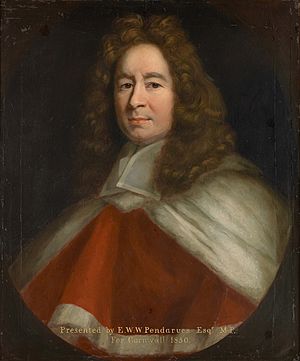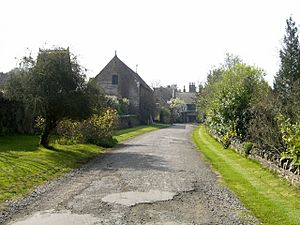William Gregory (1625–1696) facts for kids
Sir William Gregory (born March 1, 1625 – died May 28, 1696) was an important British judge and politician. He grew up in Fownhope, where his father was a vicar. William went to Hereford Cathedral School and then All Souls College, Oxford. After his studies, he trained to become a lawyer at Gray's Inn.
In 1653, he married Katharine Smith. They had one son, James. William Gregory became well-known in 1677 when he was chosen as a Serjeant-at-law, a special type of lawyer. That same year, he became a Member of Parliament for Weobley.
Contents
Sir William Gregory's Political Journey
Becoming a Speaker of Parliament
After just one year in Parliament, William Gregory was chosen for a very important job: Speaker of the House of Commons. This happened during a special Parliament called the Habeas Corpus Parliament. The King and Parliament disagreed on who should be Speaker. Sir William Gregory was chosen as a good compromise.
Helping Pass Important Laws
As Speaker, Gregory played a key role in creating the Habeas Corpus Act 1679. This law was very important for protecting people's rights. It made sure that no one could be held in prison without a good reason. After this, he was made a knight and became a judge called a Baron of the Exchequer. In 1689, he became the Chief Justice of the King's Bench, which was the highest judge position at the time. He held this job until he passed away.
Life at How Caple Court
In 1677, Sir William Gregory bought a large estate called How Caple in Herefordshire. This land had been owned by the Caple family since 1289. He bought more land nearby, including the areas of Woolhope and Fownhope. Sir William spent most of his free time at How Caple. He started building a grand house there, which is known as How Caple Court.
Sir William's Health and Legacy
Dealing with Illness
Sir William Gregory faced a difficult illness: kidney stones. He was very brave about it. In a letter from 1694, he wrote that his illness was very tough. He had been stuck in his room for three months. He trusted that God would help him through it.
Rebuilding the Local Church
In his will, Sir William left enough money to rebuild the local church, St Andrew and St Mary at How Caple. This work happened between 1693 and 1695. The church's main part was rebuilt, but the older, medieval part (called the chancel) stayed the same. Even though it was built during a time when architecture wasn't always admired, the church is still praised for its beauty today.
You can find more details about Sir William's political life online at The History of Parliament Online.



